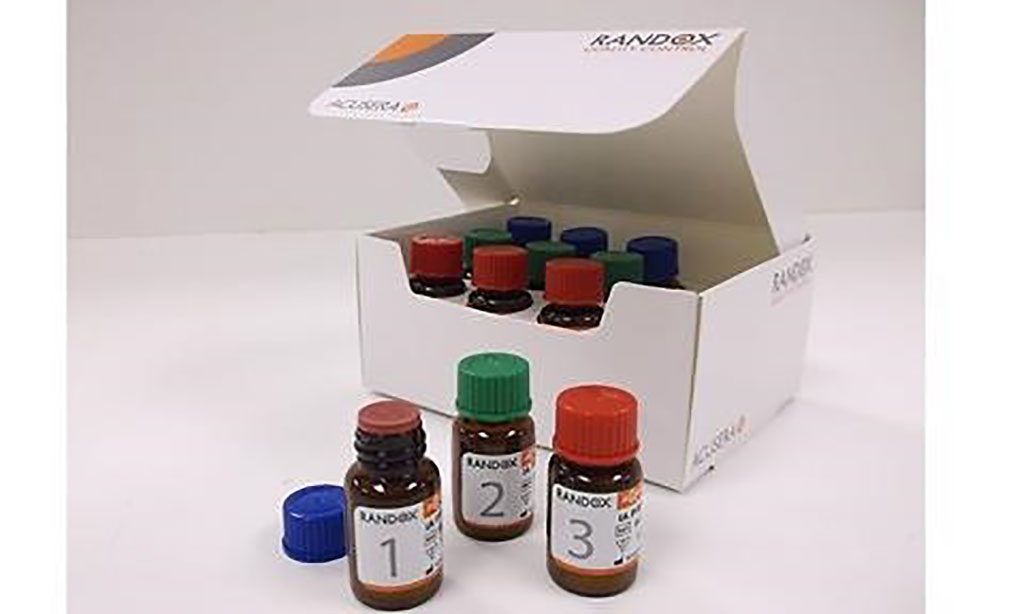Biochemical Parameters Compared for Diabetic Ketoacidosis Severity
By LabMedica International staff writers
Posted on 19 Jan 2022
Diabetic ketoacidosis (DKA) is a life-threatening acute complication of diabetes mellitus characterized by hyperglycemia and ketoacidosis. It can occur in both type 1 diabetes (T1DM) and type 2 (T2DM) diabetes patients under stress conditions.Posted on 19 Jan 2022
Laboratory findings in DKA consist of hyperglycemia, high anion gap metabolic acidosis, and detection of serum ketone or urine ketone bodies. Three types of ketone bodies, acetoacetate, beta-hydroxybutyrate (BHB), and acetone, are produced in DKA. The ratio of BHB to acetoacetate in patients with DKA is increased by 10 times compared with the healthy population.

Image: The D-3-Hydroxybutyrate (Ranbut) assay is a superior marker of ketoacidosis (Photo courtesy of Randox)
Endocrinologists at the Maharaj Nakorn Si Thammarat Hospital (Muang, Thailand) and their colleagues recruited 99 patients with type 1 or type 2 diabetes mellitus that were diagnosed with DKA between October 1, 2018 and September 30, 2020 into a prospective observational study. The inclusion criteria were: age > 18 years, diagnosed with DKA and admitted to the hospital, serum blood glucose ≥250 mg/dL and serum BHB ≥3 mmol/L, and venous blood pH < 7.3 or serum bicarbonate < 18 mmol/L.
Serum BHB was measured by an enzymatic method, the Ranbut assay, (Randox Laboratories Limited, Crumlin, UK). The test was linear for serum BHB at 0.1–5.75 mmol/L and had a correlation coefficient of r = 0.9954. Serum glucose, blood urea nitrogen (BUN), creatinine, serum lactate, and serum electrolytes were measured using a c501 module of the Cobas 6000 analyzer series (Roche Diagnostics, Rotkreuz, Switzerland).
The investigators reported a total of 99 diabetes patients were diagnosed with DKA (mean age 39.4 years, 63.4% female, 53.6% T2DM). while infection was the most common precipitating factor in T2DM (43.4%), non-compliance with treatment was the most common precipitating factor in T1DM (43.5%). The initial laboratories evaluation of patients did not significant differ between type1 and type2 diabetes. Serum BHB during treatment of DKA was significantly correlated with changes in serum bicarbonate, serum anion gap, and venous pH. The serum BHB levels corresponding to HCO3 levels for DKA severity were 4.5, 5.7, and 5.9 mmol/L in mild, moderate, and severe DKA, respectively. The serum BHB level of < 1 mmol/L had 73.7% sensitivity and 100% specificity to predict DKA resolution. Median time to resolution of DKA was 12 hours with an optimized BHB cut-off value of < 1 mmol/L. There were no significant difference in time to resolution of DKA in the patients with type 1 and type 2 diabetes.
The authors concluded there are no differences in DKA-related biochemical parameters between type 1 and type 2 diabetes patients. The present findings suggest that DKA should be assessed and treated similarly, regardless of its occurrence in type 1 or type 2 diabetes patients. The study was published on January 6, 2022 in the journal BMC Endocrine Disorders.
Related Links:
Maharaj Nakorn Si Thammarat Hospital
Randox Laboratories
Roche Diagnostics













